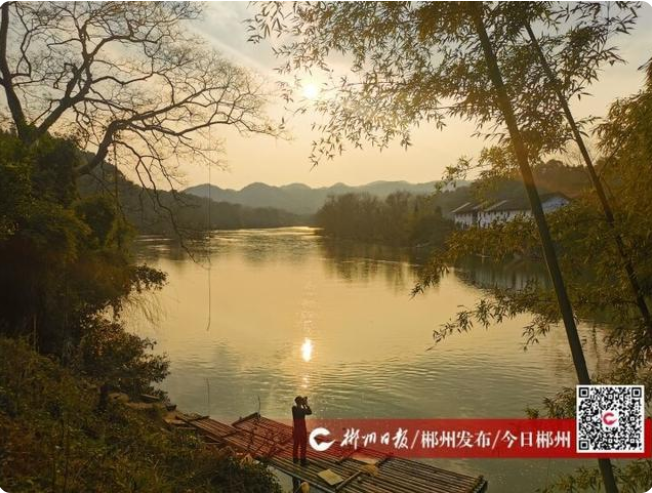Chenzhou story of rural revitalization
2022-08-04 10:49:07
Relying on the precious natural resources like lucid waters, lush mountains and rural areas in recent years, Niuya Village has adjusted measures to local conditions to drive the rural development of the industry bred in the landscape pastoral, so as to turn the green mountains into gold and silver mountains. The picture of rural revitalization, in which people are rich and living a happy life, is slowly unfolding.

Quality of living environment greatly improves
Located in the middle of the lower reaches of the Xihe River Scenic Belt, the transportation in Niuya Village is very convenient. It’s 13 kilometers away from the street and 4.5 kilometers away from the county seat.
The village covers 8 village groups, with a population of 1,295 in 438 households, an arable land area of 595 mu (about 39.67 hectares) and a total forest area of 7,600 mu (around 506.67 hectares).
There are also cultural landscapes like the Yuquan Temple and the White Tiger Temple. In front of the Yuquan Temple, thousand-year-old ginkgo trees and square bamboos flourish, attracting a constant stream of tourists every year.
“The transformation of Niuya Village has taken us a long time and a lot of work,” said Li Yong, secretary of the Party branch of Niuya Village, Xiangyindu Sub-district, Yongxing County.
The main industry in the village was coal mining for a long time. The walls became darker and darker along the direction of the mine.
In order to eliminate inefficient and ineffective production capacity, the village closed down two backward coal mines, and did a good job in environmental sanitation improvement, demolition of hollow houses, cleaning and greening of pond bank slope and so on in 2020.

Nowadays, the messy scene near the mine has gone. The thousand-year-old ginkgo trees inside the rebuilt Yuquan Temple form a unique landscape, attracting many tourists.
At present, all dry pail latrine, debris in sight, abandoned old houses and all kinds of illegal buildings in the village have been torn down. There is no phenomenon like littering or scattering sundry carelessly.
The view of today’s Niuya Village is enchanting along the Xihe River trail, with clean and tidy roads, mutual reflected flowers and plants, regular electricity lines and renovated restrooms.
Integration of agriculture, culture and tourism industry drives villagers’ income growth
Because of the wonderful landscape, the Beach Park in Laowan Group of Niuya Village has become an Internet-famous site, with photography enthusiasts, anglers and cyclists coming in an endless stream.
“We will take advantage of this site to excavate the water culture of the river basin, build a walkway and suspension bridge on the river dam, and create a flower gallery in the sky.” Li Yong said that the “two committees” of the village branch are striving for the pilot construction of water conservancy cultural tourism projects like water conservancy cultural theme parks.
Last year, Niuya Village mobilized the local talent to help build a new pig farm, which will be put into production this year. 6,000 pigs are expected to be sold annually in the initial stage.
In the next step, on the basis of protecting the ecological environment, the village will drive industrial development with rural tourism and make rural revitalization benefit every household by making use of bamboo forests, farmland as well as river courses, introducing market entities and supporting villagers to engage in agritainment and homestay inns.
“We will integrate the woodland, mountain land and wasteland to develop characteristic rural leisure tourism,” Li Yong said.
They have applied for an additional courier station in the village to develop an ecological farm with agricultural sightseeing, farming experience and attractive farmhouse customs, which can not only solve the problems of eating, accommodation and transportation for tourists and boost the village collective economy, but also make the courier station into a window to show the image of the Xihe River Scenic Belt.
In order to develop industries, the “two committees” of the village branch worked together and pooled their ideas. “We have transferred more than 200 mu (about 13.33 hectares) of land to introduce high-standard farmland construction projects and develop modern facility agriculture,” Li Yong disclosed.
Great efforts will be made to improve the average planting efficiency, like rectifying arable abandonment, introducing large grain growers and utilizing the continuous planting mode of “rice + other crops”.
Li Yong revealed, “we also plan to set up a finishing plant for bamboo crafts in the former coal mine site.” The “two committees” of the village branch and the shuttered coal mining enterprises are also discussing ways to transform the industry. There is a large bamboo forest in the village.
Generally, bamboo is cut down and made into common agricultural tools such as dustpans and brooms, which can only be sold for few dollars. But if it is made into bamboo carving crafts, the value is several times higher than agricultural supplies.
“These are our preliminary plans in the next five years, and we will implement them one by one. We hope to develop Niuya Village into a beautiful village that is visible, touchable, livable and tour-friendly.”




